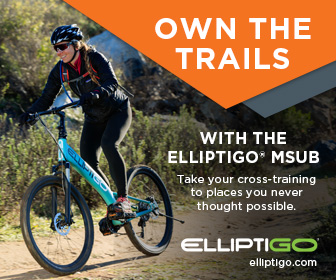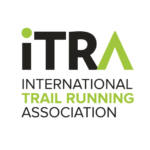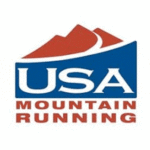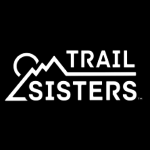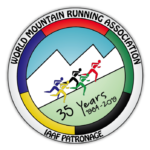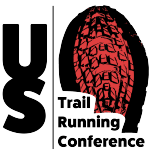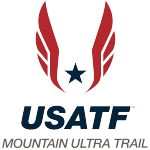
Tayte Pollmann’s articles are supported by American Trail Running Association corporate member Nike Trail Running. You can follow Tayte’s adventures on Facebook, Twitter and Instagram. If you liked this article, read even more of Tayte’s articles on our website.
This past weekend February 28 through March 1, I attended the 2020 Dion Snowshoes U.S. National Snowshoe Championships in Leadville, CO, elevation 10,200 feet, making it America’s highest incorporated city. Before this event, I had never been to a snowshoe running event or worn a pair of running snowshoes. I decided to jump into Saturday’s recreational 5K and Sunday’s 4 x 2.5K relay events to discover what snowshoe running is all about. Listed below are my top takeaways from my first snowshoe running experience.

Choose Your Snowshoes Wisely
Just like with trail running shoes, there are a wide variety of running snowshoes with different styles and functions. In comparison to classic snowshoes, running snowshoes are smaller, lighter, and designed specifically for running. Several factors to consider when choosing your running snowshoe are: weight/size, feel, traction, and mounting system.
- Weight/Size: Generally, the lighter and smaller the snowshoe, the faster you can run. Some of the highest quality snowshoes on the market can weigh as low as 21.5oz a pair. To put that into perspective, an average trail running shoe, the Nike Zoom Wildhorse 5, weighs 10.66 oz in a men’s size 10. There are times when smaller and lighter is not always faster, such as when the snow is deep and powdery. These conditions may require snowshoes with larger surface areas to stay afloat on the soft snow. The United States Snowshoe Association (USSSA) has minimum surface area regulations for racing snowshoes, which you can read here to make sure your snowshoes are legal for competition.
- Feel: Choose a snowshoe that feels natural on your feet and doesn’t change your running stride. Some of the top running snowshoes brands on the market, such as Northern Lites, Dion Snowshoes and Atlas Snow-Shoes do a great job of designing snowshoes that work naturally with the running motion.
- Traction: Similar to classic snowshoes, running snowshoes have metal spikes, crampons, cleats or other heavy-duty traction devices on the bottom of the snowshoe to give you traction in slippery conditions. Depending on the course, you may encounter varying degrees of slick snow and ice, which can determine the kind of traction system you need. Research beforehand the style of traction offered by different snowshoe models and when to use each one.
- Mounting System: Running snowshoes come in several different styles for mounting your shoes on the snowshoes. Direct mounted snowshoes permanently attach directly to your shoes with bolts and locking nuts. (See direct mount instructions in the video below). Most snowshoes use a binding systems with adjustable straps which allow athletes to use any shoes. Choose the mounting system that best secures your shoe to the snowshoe. Your shoe shouldn’t slide in the snowshoe or this could lead to your snowshoe falling off (you can be disqualified from a snowshoe race if your snowshoe falls off and you don’t stop and immediately put it back on).
Trust in Your Trail Running
Trail running is one of the best crossovers sports for snowshoe running. Before running in snowshoes, I was worried that it would be a completely different experience than trail running. I assumed that the snowshoe’s wide frame would force me to run with a wider gait. After one test run in Dion Snowshoes, my worries were put to rest. My stride felt almost completely normal and I didn’t notice myself having to think about widening my gait. I did notice myself thinking about picking my feet up, likely due to the additional weight of the snowshoes. Overall, if you are comfortable trail running, you will likely transition easily into snowshoe running.
Join the Passionate Snowshoe Running Community
The best part of my experience at the 2020 Dion Snowshoes U.S. National Snowshoe Championships was connecting with the amazing people in the snowshoe running community. Snowshoe running, like subdivisions of trail running such as ultra-running or skyrunning, has its passionate followers. Although snowshoe running is a small community, there are snowshoe athletes around the world, national and world level competitions, specific associations such as the World SnowShoe Federation (WSSF) and United States Snowshoe Association (USSSA) and media including Snowshoe Magazine. The runners I met this weekend were a very kind and close-knit group, many of whom had been a part of the snowshoe community for years. Runners came to Leadville from all over the country, representing 18 states including Colorado, California, Oregon, Michigan, Wisconsin, Vermont, Minnesota, Massachusetts, New York, Washington, Iowa, Maine, West Virginia, Alaska, Idaho, New Hampshire, New Jersey and Utah.

Dress Appropriately
Since most snowshoe races take place during winter in cold climates, it’s important to dress appropriately. First, wear water-resistant socks and trail running shoes. Although snowshoes will help to keep you from sinking in the snow, you will inevitably still get snow on your shoes. This snow can melt and make your feet wet, leading to blisters or even worse conditions such as frostbite in your toes. Second, wear water-wicking materials on your legs and upper body. Snowshoes often flick up small chunks of snow and ice when you run. Runners with particularly strong back-kicks may find themselves flinging snow onto their back throughout the run, which can get them wet and cold. Third, bring a fresh change of clothes for after the race. Although you may be able to wear less layers during a race, you will likely need warmer and dryer clothes post-race. Finally, if conditions are sunny, make sure you apply sunscreen regularly and wear sunglasses. Sunlight reflects off snow and becomes more intense, which can cause sunburns and eye damage.
Feel the Snow
In trail running, we find ourselves looking for the best places to put our feet on the trail. We watch out for tripping hazards such as roots and rocks and look for firm ground where we can push off. The same awareness applies to snowshoe running. Seek out firmer snow where you can push off most efficiently. Avoid trudging through powder when you don’t have to, as this requires extra energy. Be cautious of ice, but also know that with proper traction on your snowshoes you may find yourself able to run faster on ice than on soft snow.
Ready to run a snowshoe race? See our list of upcoming snowshoe running events across the United States.

Do you like Tayte Pollmann’s articles? You can support the creation of this content by making a tax-deducible donation to the American Trail Running Association via PayPal by clicking the “Donate” button below. ATRA is a 501(c)(3) non-profit organization.


